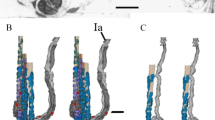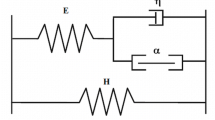Summary
With reference to experimental data and the failure of earlier proposed first order linear models of mammalian muscle spindles, a second order mechanical model of de-efferented primary endings is studied. The model takes into account the presence of two different types of intrafusal muscle fibres in a complete spindle organ. It further allows the incorporation of different gain of the mechano-electric conversion into a depolarization of the sensory terminals innervating the two types of fibres.
It is shown that a closer approximation to the behaviour of the biological prototype is obtained if the transducer gain of the branch corresponding to the nuclear bag intrafusal fibres is chosen significantly higher than that corresponding to the nuclear chain branch.
The marked nonlinear behaviour of muscle spindle primary endings as recently reported by Matthews and Stein (1968, 1969) is interpreted as a saturation effect of the high gain mechano-electric transducer of the nuclear bag branch. The saturation is considered to reflect a condition of complete depolarization of these sensory terminals. If a higher transducer gain actually is present, a complete depolarization of these terminals would occur at a lower degree of mechanical deformation than for the nuclear chain terminals. The mechano-electric transducer system of the nuclear chain fibres might thus behave approximately linearly within a larger range of input amplitudes. The greatly reduced gain of the primary endings at large emplitudes of imposed muscle vibrations as observed experimentally (Matthews and Stein, 1968, 1969) may thus be accounted for by the transducer gain of the nuclear chain fibres alone.
Similar content being viewed by others
Abbreviations
- C :
-
Viscous stiffness, or electrical capacitance
- f :
-
Frequency of a signal
- K :
-
Static gain of a system
- k :
-
Elastic stiffness
- R :
-
Electrical resistance
- s :
-
The Laplace operator
- H(s) :
-
General transfer function of a system
- X (s) :
-
Laplace transform of the difference between instantanous and resting length of the complete intrafusal muscle fibre, according to the suggested model shown in Fig. 2
- α(s) :
-
Laplace transform of the length of the elastic component of the proposed Maxwell branch of the sensory region of the model
- ψ(s) :
-
Laplace transform of the difference between instantanous and resting length of the lumped model of the polar (non-sensory) region of the intrafusal fibres
- λ(s) :
-
Laplace transform of the length of the purely elastic branch of the model
- μ α :
-
The transducer gain of the output from the α-branch relative to that of the λ-branch
- v(s) :
-
Laplace transform of the total output signal λ(s) +μ α α(s)
- τ :
-
Time constant defined by \(\tau = \frac{C}{k}\) or τ=RC for the mechanical and the electrical system respectively
- ω :
-
Angular frequency equal to 2πf
- η :
-
Rate constant describing the relation between the lead and the lag time constant of a first order lead-lag filter network
References
Alnaes, E., Jansen, J. K. S., Rudjord, T.: Fusimotor activity in the spinal cat. Acta physiol. scand. 63, 197–212 (1965).
Barker, D. (ed.): Symposium on muscle receptors. Hong Kong: Hong Kong University Press 1962.
Boyd, I. A.: The structure and innervation of the nuclear bag muscle fibre system and the nuclear chain muscle fibre system in mammalian muscle spindles. Phil. Trans. B 245, 81–136 (1962).
Cooper, S.: Muscle spindles and other muscle receptors. In: G. H. Bourne (ed.), The structure and function of muscle. New York: Academic Press 1960.
Crowe, A.: A mechanical model of the mammalian muscle spindle. J. theoret. Biol. 21, 21–41 (1968).
—: The effects of stimulation of static and dynamic fusimotor fibres on the response to stretching of the primary endings of muscle spindles. J. Physiol. (Lond.) 174, 109–131 (1964a).
— Further studies of static and dynamic fusimotor fibres. J. Physiol. (Lond.) 174, 132–151 (1964b).
Edwards, C.: Changes in the discharge from a muscle spindle produced by electrotonus in the sensory nerve. J. Physiol. (Lond.) 127, 636–640 (1955).
Eldred, E., Yellin, H., Gadbois, L., Sweeney, S.: Bibliography on muscle receptors; their morphology, pathology and physiology. Exp. Neurol., Suppl. 3, 1–154 (1967).
Granit, R.: Receptors and sensory perception. New Haven: Yale University Press 1955.
— (ed.): Nobel Symposium I. Muscular afferents and motor control. Stockholm: Almqvist & Wiksell 1966.
Henatsch, H. D.: Instability of the proprioceptive length servo: Its possible role in tremor phenomena. In: M. D. Yahn and D. D. Purpura (ed.), Neurophysiological basis of normal and abnormal motor activities. New York: Raven Press, Hewlett 1967.
Houk, J. C., Cornew, R. W., Stark, L.: A model of adaptation in amphibian spindle receptors. J. theoret. Biol. 12, 196–215 (1966).
Jansen, J. K. S.: On the functional properties of stretch receptors of mammalian skeletal muscles. In: A. V. S. de Reuck and J. Knight (ed.), Ciba foundation symposium on myotactic and vestibular mechanisms. London: J. E. A. Churchill Ltd. 1967.
— Matthews, P. B. C.: The central control of the dynamic response of muscle spindle receptors. J. Physiol. (Lond.) 161, 357–378 (1962).
— Poppele, R. E., Terzuolo, C. A.: Transmission of proprioceptive information via the dorsal spinocerebellar tract. Brain Res. 6, 382–384 (1967).
Landon, D. N.: Electron microscopy of muscle spindles. In: B. L. Andrew (ed.), Control and innervation of skeletal muscles. Edinburgh and London: University of St. Andrew, E. & S. Livingstone Ltd. 1966.
Lippold, O. C. J., Nicholls, J. G., Redfearn, J. W. T.: Electrical and mechanical factors in the adaptation of a mammalian muscle spindle. J. Physiol. (Lond.) 153, 209–217 (1960).
Matthews, B. H. C.: The response of a single end organ. J. Physiol. (Lond.) 71, 64–110 (1931).
— Nerve endings in mammalian muscle. J. Physiol. (Lond.) 78, 1–53 (1933).
Matthews, P. B. C.: The response of de-efferented muscle spindle receptors to stretching at different velocities. J. Physiol. (Lond.) 168, 660–678 (1963).
— Muscle spindles and their motor control. Physiol. Rev. 44, 219–288 (1964).
Matthews, P. B. C., Stein, R. B.: The sensitivity of muscle spindle afferents to sinusoidal stretching. J. Physiol. (Lond.) 198, 43–44 P (1968).
— The sensitivity of muscle spindle afferents to small sinusoidal changes of length. J. Physiol. (Lond.) 200, 723–743 (1969).
Rudjord, T.: Current spread in sensory terminals of the mammalian muscle spindle receptors. (In press.)
Smith, R. S.: Properties of intrafusal muscle fibres. In R. Granit (ed.), Nobel Symposium I. Muscular afferents and motor control. Stockholm: Almqvist & Wiksell 1966.
Stein, R. B., Matthews, P. B. C.: Differences in variability of discharge frequency between primary and secondary muscle spindle afferent endings of the cat. Nature (Lond.) 208, 1217–1218 (1965).
Toyama, K.: An analysis of impulse discharges from the spindle receptor. Jap. J. Physiol. 16, 113–125 (1966).
Vossius, G.: Das System der Augenbewegung. Z. Biol. 112, 27–57 (1960).
Author information
Authors and Affiliations
Rights and permissions
About this article
Cite this article
Rudjord, T. A second order mechanical model of muscle spindle primary endings. Kybernetik 6, 205–213 (1970). https://doi.org/10.1007/BF00276721
Received:
Issue Date:
DOI: https://doi.org/10.1007/BF00276721




